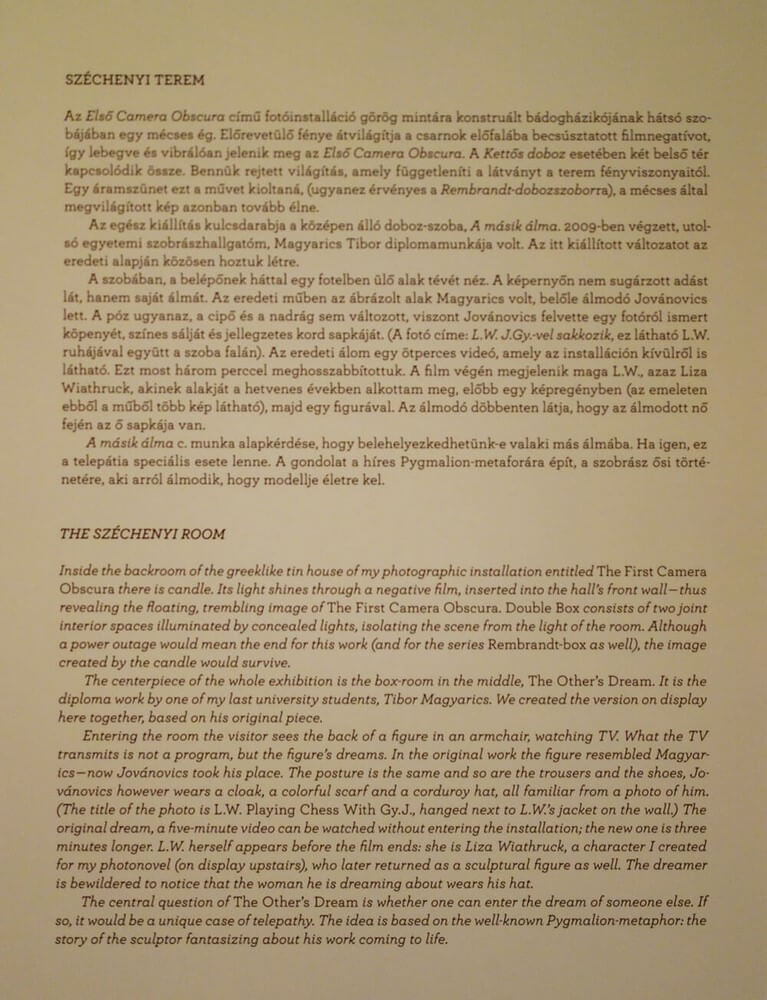SZÉCHENYI TEREM – THE SZÉCHENYI ROOM
Széchenyi terem
Az Első Camera Obscura című fotóinstalláció görög mintára konstruált bádogházikójának hátsó szobájában egy mécses ég. Előrevetülő fénye átvilágítja a csarnok előfalába becsúsztatott filmnegatívot, így lebegve és vibrálóan jelenik meg az Első Camera Obscura. A Kettős doboz esetében két belső tér kapcsolódik össze. Bennük rejtett világítás, amely függetleníti a látványt a terem fényviszonyaitól. Egy áramszünet ezt a művet kioltaná, (ugyanez érvényes a Rembrandt-dobozszoborra), a mécses által megvilágított kép azonban tovább élne.
Az egész kiállítás kulcsdarabja a középen álló doboz-szoba, A másik álma. 2009-ben végzett, utolsó egyetemi szobrászhallgatóm, Magyarics Tibor diplomamunkája volt. Az itt kiállított változatot az eredeti alapján közösen hoztuk létre.
A szobában, a belépőnek háttal egy fotelben ülő alak tévét néz. A képernyőn nem sugárzott adást lát, hanem saját álmát. Az eredeti műben az ábrázolt alak Magyarics volt, belőle álmodó Jovánovics lett. A póz ugyanaz, a cipő és a nadrág sem változott, viszont Jovánovics felvette egy fotóról ismert köpenyét, színes sálját és jellegzetes kord sapkáját. (A fotó címe: L.W. J.Gy.-vel sakkozik, ez látható L.W. ruhájával együtt a szoba falán). Az eredeti álom egy ötperces videó, amely az installáción kívülről is látható. Ezt most három perccel meghosszabbítottuk. A film végén megjelenik maga L.W., azaz Liza Wiathruck, akinek alakját a hetvenes években alkottam meg, előbb egy képregényben (az emeleten ebből a műből több kép látható), majd egy figurával. Az álmodó döbbenten látja, hogy az álmodott nő fején az ő sapkája van.
A másik álma c. munka alapkérdése, hogy belehelyezkedhetünk-e valaki más álmába. Ha igen, ez a telepátia speciális esete lenne. A gondolat a híres Pygmalion-metaforára épít, a szobrász ősi történetére, aki arról álmodik, hogy modellje életre kel.
The Széchenyi Room
Inside the backroom of the greeklike tin house of my photographic installation entitled The First Camera Obscura there is candle. Its light shines through a negative film, inserted into the hall’s front wall—thus revealing the floating, trembling image of The First Camera Obscura. Double Box consists of two joint interior spaces illuminated by concealed lights, isolating the scene from the light of the room. Although a power outage would mean the end for this work (and for the series Rembrandt-box as well), the image created by the candle would survive.
The centerpiece of the whole exhibition is the box-room in the middle, The Other’s Dream. It is the diploma work by one of my last university students, Tibor Magyarics. We created the version on display here together, based on his original piece.
Entering the room the visitor sees the back of a figure in an armchair, watching TV. What the TV transmits is not a program, but the figure’s dreams. In the original work the figure resembled Magyarics—now Jovánovics took his place. The posture is the same and so are the trousers and the shoes, Jovánovics however wears a cloak, a colorful scarf and a corduroy hat, all familiar from a photo of him. (The title of the photo is L. W. Playing Chess With Gy. J., hanged next to L. W.’s jacket on the wall.) The original dream, a five-minute video can be watched without entering the installation; the new one is three minutes longer. L. W. herself appears before the film ends: she is Liza Wiathruck, a character I created for my photonovel (on display upstairs), who later returned as a sculptural figure as well. The dreamer is bewildered to notice that the woman he is dreaming about wears his hat.
Exhibited in:

